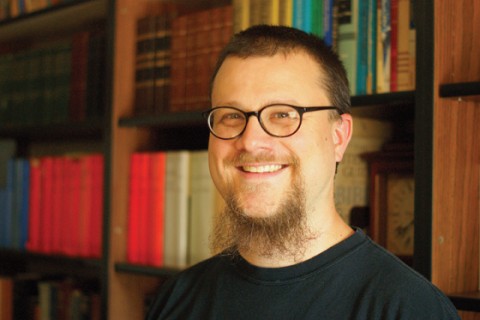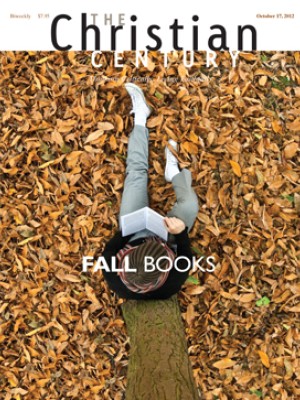The reading congregation: Editor Christopher Smith

Emerging from Englewood Christian Church in Indianapolis, the Englewood Review of Books is a weekly online book review and quarterly print magazine that goes out to members and friends of the congregation. We talked to the editor, C. Christopher Smith, about how this literary enterprise got started and about its place in congregational life.
How did your church come to have a strong focus on books?
We’ve long had many readers in our congregation, but the story of the Review goes back about 17 or 18 years. We had a Sunday night service that was a “lite” version of the Sunday morning service, and there was a lot of dissatisfaction with it. We didn’t want to give up meeting together, but it was time to let the format die. We stumbled on the idea of having a conversation together. One of the first things we learned was that we didn’t really know how to talk to each other.
Read our latest issue or browse back issues.
We had older people who had been in our church for many decades, many of whom had strong, traditional ideas about what the church was and what it should be about. We also had some people who had done some serious reading of contemporary theological texts—by authors like John Howard Yoder and Gerhard Lohfink—who had pretty strong ideas as well. There was a big gap between those two parties’ concept of church, with many people scattered in between.
We started with the question “What is the gospel?” Our conversation over the years did not yield a lot of answers, but it started to forge a trust that allowed us to be able to work together even when we didn’t see eye to eye on foundational questions.
Books became a fuel for our conversation. As the conversation went along, somebody would say, “Oh, maybe we should read this chapter from this book before next week.” We eventually developed the practice of reading books together as well as scripture.
How did that experience lead to the Review?
It started in 2007 as an e-mail list: we just sent out one review a week to about 100 of our friends around the U.S. About six months into it, we decided to set up a website to archive the reviews and give the current review a little more presence and invite others into the conversation. In 2010 we decided to do a quarterly print magazine. We felt like we were moving against the cultural tide.
Why the move to print?
There is something compelling about being able to put something into people’s hands. The way things are going, almost everybody has a website. Sure, you may see a website and appreciate something there, but three weeks later it is not too likely that you are going to remember what that was. You are more likely to remember something you’ve had in your hand.
The church valued the experience in the book business that I had when I came here. Slowly, we found a way for me to use those skills to edify not only our church community but a lot of other communities. Among us were other folks with experience in the book world. One church member had worked in a print shop for a long time, and he had a lot of layout skills and print knowledge. His son, an art professor, does the design, layout and cartooning for the print magazine.
What are the themes and interests that drive the Review?
We are working from the assumption that God is reconciling all things and that the church is called into this mission. This will engage us in conversations about ecology, education, economics, community development, child care, families—all of those things; there is nothing that is out of bounds. We look for both practical, do-it-yourself books as well as theoretical books.
Who is your audience?
The primary audience is churches, as opposed to isolated individuals or the academy. Our aim is to nurture slow and attentive reading as a practice that is valuable for churches. We believe that God wants us to read, to think and to be challenged in our churches. Being called to God’s reconciling work requires a good deal of reflection, and it requires understanding who we are and where we are and what gifts we have and how we leverage those gifts. All of those conversations, reflections and discernments are, for us, what the life of the church is about. Reading feeds those conversations.
It sounds like a very reflective setting—almost like an ivory tower.
Quite the opposite. Englewood Christian Church is in an urban neighborhood in Indianapolis, with all the typical challenges of such places. Our zip code area is near the top nationwide in rates of abandoned housing. We were a kind of megachurch, which peaked in size in the early 1970s. The population of the church declined rapidly in the late 1970s and early 1980s as people fled the neighborhood. Somewhere in the early ’80s the church had to make a decision. Do we follow our members and other churches to the suburbs or do we stay put? The leaders at that time decided that it was really important to stay in the neighborhood.
The journal and book work are not separate from all of the neighborhood ventures and partnerships that we’ve made as a church. We run a landscaping business that employs local young people. We’ve helped open a cooperative grocery store. We run a daycare center. We’ve worked on turning an abandoned local school into mixed-income housing with apartments specifically for mentally ill and disabled adults.
Of all the enterprises that the church runs and is involved in, the book review is perhaps the most oriented outside the immediate neighborhood. We have a small bookstore in the church, and I would love someday to have a store that is more accessible to the neighborhood. But our work with the Review helps provide the narrative and the rationale for a lot of the other things going on in the church, to people both inside and outside the congregation.
What books have you read recently that left their mark on you?
Christine Pohl’s Living into Community fits well with who we are at Englewood; it could draw us deeper into the particular practices she describes—gratitude, making and keeping promises, truthfulness. Brian McLaren’s Why Did Jesus, Moses, the Buddha, and Mohammed Cross the Road? is timely and important. Our culture is driven by hostility, and our Christian faith has fed that hostility. McLaren is trying to move us away from that.
Rereading Chris Rice and Emmanuel Katongole’s book Reconciling All Things has led me to think a lot about lament and their idea that lament helps us to unlearn speed, distance and innocence. That has been helpful to me in thinking about all the painful stuff recently—the shootings in Colorado and at the Sikh Temple in Wisconsin, the Chick-fil-A debacle. We don’t know how to lament. What Rice and Katongole mean by unlearning innocence is confessing our complicity in the situations we lament.







